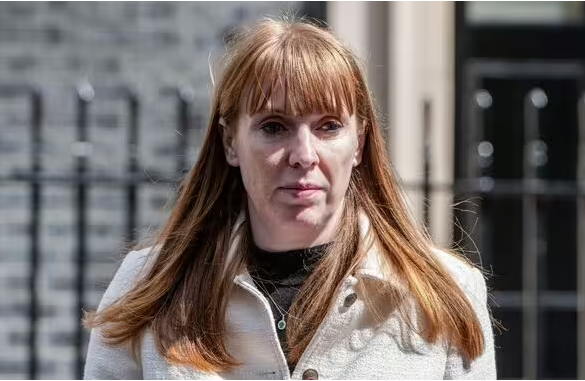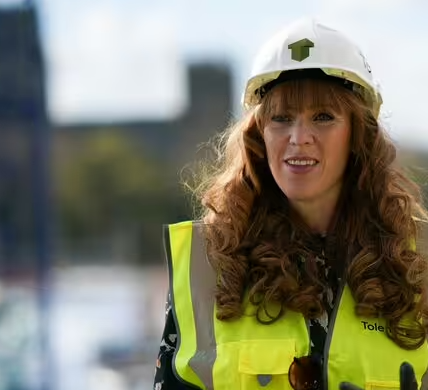EXCLUSIVE: Angela Rayner’s plan to build 1.5 million new homes is more about personal ambition than a serious plan, an MP has said.

Angela Rayner has been warned she is at risk of missing Labour’s 1.5m new homes target (Image: Getty)
Angela Rayner‘s plan to build 1.5 million homes has seen Whitehall diktats impose “ridiculous” targets on a “beautiful” part of Kent and risk “real harm” to green belt land. The Deputy Prime Minister is on track to miss her housebuilding target, with estimates new build completions are flatlining at an annual rate of around 200,000 a year. The bad news comes as Labour marks the first anniversary of its General Election victory today (July 5).
The Home Builders Federation (HBF) reached the damning conclusion based on the number of energy performance certificates issued since Labour swept to power 12 months ago. Its estimate means the Government has fallen 100,000 behind its target over the last year. The HBF said the country is “well below” where it needs to be when it comes to planning permissions over the next two to four years. The Government has insisted that the 1.5 million homes is a target for the whole Parliament and shouldn’t be broken down into annual numbers.

Sevenoaks district has a new homes target of 1,149 (Image: Getty)
The Government estimates 186,600 net additional homes were delivered in England between the start of Parliament on July 9, 2024, and June 15 this year. But HBF analysis in June found the number of new home building sites granted planning approval in England during the first three months of this year was the lowest since reporting began 20 odd years ago, according to the HBF, adding to the risk Labour won’t hit the 1.5 million mark. A report published by Savills in June showed demand falling in the housing market.
Shadow Housing Secretary Kevin Hollinrake told the Express Ms Rayner’s figures were plucked from thin air and more about her own personal ambition.
He said: “Of course we need more homes – but Labour’s top-down 1.5 million target is completely unworkable and risks doing real harm. It ignores local need and local voices, forcing urban sprawl on areas like Sevenoaks, which is seeing housing targets rise by 63%. That means acre after acre of greenfield land lost, without the infrastructure or services to support the population increase.
“Angela Rayner’s figures are plucked from thin air – more about personal ambition than a serious plan for the country.”
He added: “In the rush to hit these numbers, we risk ending up with sub-standard homes in the wrong places. We need the right homes, in the right places – with proper local input, not diktats from Whitehall.”
Sevenoaks has seen its housebuiling target rise from 165 to 704 under previous governments to a mandatory target of 1,149 under Labour. Sevenoaks District Council said it welcomed efforts to boost local housing supply, but was “deeply disappointed” national policies have been introduced by Labour which it said would force many local authorities to develop green belt land.
Conservative district councillor, Nigel Williams, told the Express: “We don’t know how they (Labour) arrived at this figure, but it’s ridiculous. They’ve imposed this target without paying enough attention to practicalities which come from a lack of infrastructure.”
He said local roads, schools, GP surgeries and other services would be under even greater pressure from a surge in population as people move to the area.
Cllr Williams said: “A lot of people here are absolutely horrified. It’s a very beautiful, historic place. We know we need to build new housing: for the elderly so they can downsize, for young families so they can move up the property ladder and for people living with parents because there’s nothing affordable.”
He joined other locals concerned the rush to meet a seemingly arbitrary target would result in substandard builds, creating “the slums of the future”.
Nationally, the Government has been warned by industry bodies, training providers and companies that a lack of bricklayers and scaffolders also threatens to derail efforts to meet the 1.5 million target.
Ahead of the Spending Review, a report from public affairs firm WPI Strategy and economics consultancy Chamberlain Walker found 75,000 fewer homes would be built by small housebuilders before the next general election as red tape added £5billion to costs.
In Kent, there are also concerns new builds will be concentrated around hamlets and villages across Kent to prevent urban sprawl in towns such as Sevenoaks. Mr Williams suggested the new homes targets threaten to unleash a backlash.
He said: “The people of Sevenoaks and surrounding area will not be sitting on their fences. They understand they have to do something [towards efforts to build new homes], but they won’t want to lose what they have.”
On whether Labour can meet its target, he said: “I don’t think so. I don’t think it’s achievable without real thought about infrastructure.”
Debbie Buckley from the New Edenbridge District Residents’ Association (NEDRA) told the Express that the members of their town, which has a population of around 9,000 and forms part of the Sevenoaks area, want affordable housing built.
She said: “We would like young people to have first dibs, but it doesn’t always work out that way.”
House prices in Sevenoaks saw an overall average of £861,954 over the last year, according to Rightmove.
NEDRA’s members fear property developers or investors could hold onto undeveloped land in the town for years, expecting its value to rise before selling sites for profit. Another concern is developers promising a certain amount of affordable housing at the planning stage before dropping numbers once permission has been granted.
Asked if the group could be seen as Nimbies, Ms Buckley said: “Not at all. We understand the need for affordable housing. What we’re not clear on is how that’s being delivered. We are also worried about the green belt and biodiversity loss.”
Under the Government’s Planning and Infrastructure Bill developers will be allowed to destroy natural habitats as long as they pay into a nature restoration levy. That money won’t have to go towards restoring those same sites but can be spent elsewhere.
Ms Buckley echoed sentiments voiced at local and national levels when asked about the Government’s 1.5 million new homes target. She said: “We understand the homes will help drive economic growth. This is about putting the right homes in the right places for the right people.”
In a message to the Government, she warned: “Take a step back and listen to what people are saying.”

The Government estimates more than 186,000 new homes have been built (Image: Getty)
A Ministry of Housing, Communities and Local Government spokesperson said: “The Government inherited an unprecedented housing crisis, but through our Plan for Change we will deliver our stretching target of 1.5 million homes so we can restore the dream of homeownership.
“We are taking decisive action to get Britain building again. Our revised housing targets have been set in line with the needs of local areas, so more homes will be built in the right places – but crucially not at the expense of the environment.
“Alongside this we are delivering the biggest boost to social and affordable housing in a generation backed by £39 billion investment, helping to drive UK housebuilding to its highest level in over 40 years.”
Figures show over 90,000 applications for planning permission were received in the first quarter of 2025 – a 6% increase on the same quarter last year.
Housing Minister Matthew Pennycook told a select committee of MPs in November it is a whole-Parliament target of 1.5 million rather than an annual target of 300,000. He said: “We are not going to hit a 300,000-type number in the first year.”
The Government pointed to lead times in planning, infrastructure and construction as showing inherited constraints, but said it expects the number of new homes to start rising “significantly” in the third year of the Parliament once reforms take effect.
Ministers have said they expect councils to explore all options to deliver the homes their communities need by maximising brownfield land, working with neighbouring authorities and, where necessary, reviewing Green Belt.
The Government also maintains that its new method for assessing housing needs is more objective, supports a more strategic approach, and distributes growth across wider city regions and not just to the largest urban authority within the largest cities.

